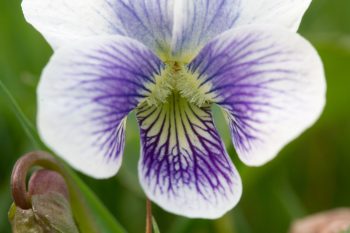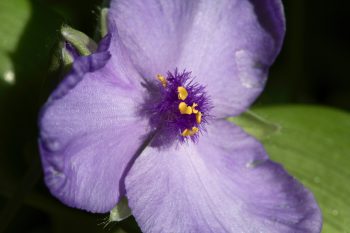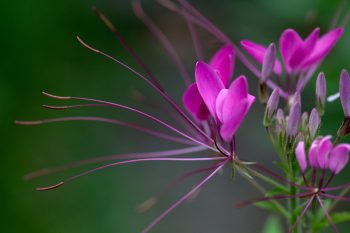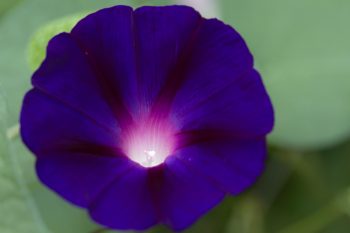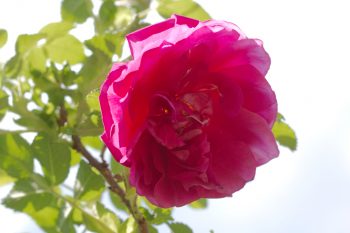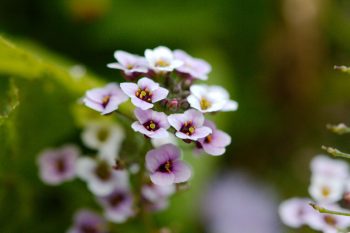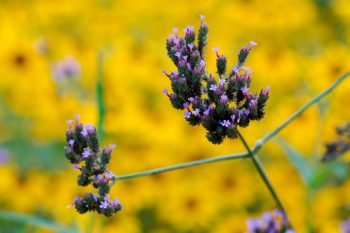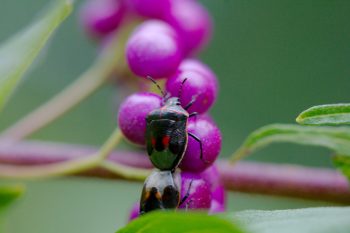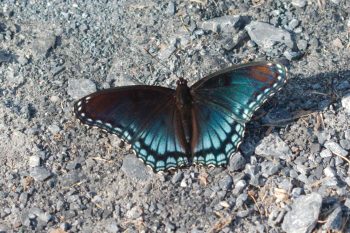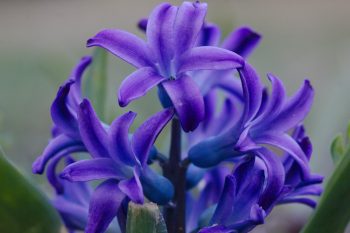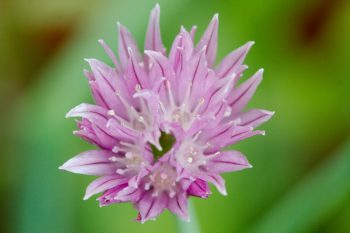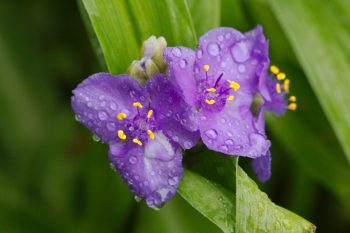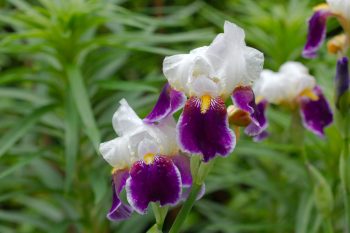If snowdrops signal the end of winter, then crocuses signal the beginning of spring for me. None of the bulbs planted last fall have started to come up yet but that’s usual. Those planted two years ago are coming up and these, which were planted in the fall of 2006, are looking good.
Tagged With: Purple
Crocuses
It Isn’t Raining Rain, You Know
….
It’s raining violets.
And when you see clouds
Upon the hill,
You soon will see crowds
Of daffodils;
So keep on looking for the bluebird,
And listening for his song,
Whenever April showers come along.
Though April showers
May come your way,
They bring the flowers
That bloom in May;
And if it’s raining,
Have no regrets;
Because, it isn’t raining rain, you know
….
April Showers, by Buddy DeSylva, 1921.
Spiderwort
This is the first bloom on our Tradescantia (spiderwort) out front in the shade garden. This one is lighter purple than most but still quite pretty. I especially like the deep purple stamen hairs and the yellow anthers. Apparently, when the stamen hairs are exposed to ionizing radiation they turn pink. Looks like were safe, for now.
Bearded Iris
The irises are starting to bloom all over. This is a purple and yellow variety outside our dining room window. I think yellow and purple are a terrific color combination.
Cleome hassleriana
Commonly known as spider flower, Cleome hassleriana is a really nice plant. It’s probably just as well that it’s an annual or it might get out of hand. This is its first bloom of the summer in our yard and it should continue until early fall.
Morning Glory
I rarely give this plant any name but bindweed and I spend a lot of time pulling it out of my garden. I do have to say, though, that for colors in the deepest registers, this is just about as good as it gets. The morning glory (along with the lowly petunia) has some of the most beautiful, deep, rich, colors in the world of flowers.
Rosa rugosa ‘Roseraie De l’Hay’
This is a large and very easily grown rugosa rose that I’ve had in the yard since we first moved here. It’s about 9 feet tall and that’s the only real problem with it. It’s too tall to really be able to appreciate most of the blooms, which are all up at the top. If given more room the branches would arch over and more flowers would be accessible but it’s not sited well enough for that. I may need to move it but it is very happy where it is. Also, the blooms are quite visible from the kitchen, which is certainly a plus. The fragrance, as with most rugosa roses, it wonderful and strong.
Siberian Iris ‘Eric The Red’
This little Siberian iris was originally planted in our garden in Gaithersburg. When we were getting ready to move I dug up a portion of it and brought it with us. It’s been doing pretty well in our yard here for ten years. Like most Siberian irises and despite being named ‘Eric The Red’, this flower is purple rather than anything you could describe as red. Some Siberian irises are much bluer, of course, so it has more red in it than those. But it’s purple, not red. Still, it’s a happy little flower and quite content without needing much of any care to do well. In a bit more sun we’d probably get more flowers but it’s happy where it is.
Tradescantia virginiana (Spiderwort)
Spiderwort (Tradescantia virginiana) is one of my favorite perennials. It’s easy to grow, it does well in sun or shade, it can take fairly dry conditions, and it blooms for a nice, long while. We have one with leaves that are very pale green, almost yellow. We have one with flowers that are much more pink and some that are nearly pure, deep blue. Each bloom lasts for a day only but there are a lot of them, following one after the other.
From the Missouri Botanical Garden page:
Genus name honors John Tradescant (1570-1638) and his son John Tradescant (1608-1662), botanists and successive gardeners to Charles I of England.
Specific epithet means of Virginia.
When the stems of spiderworts are cut, a viscous stem secretion is released which becomes threadlike and silky upon hardening (like a spider’s web), hence the common name.
Lobularia maritima (Sweet Alyssum)
As I’ve mentioned, Cathy bought a bunch of annuals to go in containers and in a few locations around the house. One that she often gets is sweet alyssum (Lobularia maritima), a pretty little thing with masses of small (7 or 8mm) flowers. This variety has a purple tint and it really lovely. I think they are particularly nice up close. On the other hand, I think a lot of things are interesting up close, which is why a significant proportion of my photography is of small things, viewed up close. Anyway, I hope you enjoy these little flowers.
Echinacea purpurea (Purple Coneflower)
The coneflower (Echinacea purpurea) has started to bloom. I often have a difficult time getting good pictures of this, because the ray florets (the ‘petals’) are often eaten into by some insect or other. They are still pretty from a distance and in mass but individually, they get to look a bit tattered. I also took some pictures of day lilies today but they put out new flowers each day and they fade before the critters have a chance to do them any harm. So, they will be around for more pictures on another day.
Verbena bonariensis
I only took a handful of pictures today and not until about 7:30, when the best light was gone. We had quite heavy rain today throughout the morning. It cleared up later but I was pretty busy and didn’t get a chance to go out. I’ve posted pictures of the Verbena bonariensis (tall verbena) growing in our yard before but I thought I’d do it again. I do love this color combination, the purple of the verbena against the yellow of the black-eyed Susans behind and below it.
Cosmopepla lintneriana (Twice-stabbed Stink Bug)
I came across another new bug today (new to me, that is). This is the twice-stabbed stink bug (Cosmopepla lintneriana), so called because of the two red ‘wounds’ the apex of the scutellum. There were at least three of them on the American beautyberry (Callicarpa americana) in our back garden, including the two shown here. I had a hard time photographing them because they kept crawling around to the underside of the branches and under the bunches of purple berries. My camera, with a 100mm macro lens and two off camera flashes is a little unwieldy and takes two hands to manage properly. So, I’d use one hand to scare the bugs onto the upper side of the branch and then let go to get the picture. By the time I had found them again through the viewfinder and focused on them, they were half way back to the underside of the branch.
Limenitis arthemis astyanax (Red-spotted Purple)
I went for a hike with a friend and his four lovely kids today. It was an absolutely gorgeous day and a perfect day to get a little bit lost. We were never really truly lost but we did miss a turn and ended up further from the car than we had originally planned. We enjoyed the woods and the kids in particular enjoyed kicking over mushrooms (after letting me get down on the ground to get a few pictures first). We also saw a slug and I got some nice pictures of that, if pictures of a slug can ever really be considered nice. This picture is a red-spotted purple (Limenitis arthemis astyanax), one of four subspecies of Limenitis arthemis. This is a very distinctive butterfly and quite a pretty thing. Yes, I know that it looks more blue than purple. It’s been mentioned. The ‘red’ spots (which are orange. I know, right?) are on the lower hind wings (i.e., the other side).
Dahlia ‘Dracula’
I posted a picture of this same dahlia on Monday, September 18, 2017, so you’ll have to excuse the repetition. Although it’s not particularly large for a dahlia flower, it’s very pretty. Also, the plant has very dark purple, not-quite-black foliage. It’s lovely overall and we definitely need to dig up the tuber and try to keep it for next year. We’ve never actually done that before and I’m not sure how successful we’ll be. They are supposed to be stored in a damp place all winter in temperatures that are between 45°F and 50°F, which is a pretty narrow range and not something we have naturally in our house. Our basement is cool but not that cool and we do our best to make it dry, not humid (it’s currently at 38% relative humidity). So, we’ll see what we can do.
Purple Hyacinths
Depending on which computer I use to look at this picture, these hyacinth flowers sometimes look a lot bluer than they are in real life. Other monitors show them the way they looked. If they look blue to you, take my word for it that they are a very strong, electric purple with just a bit of blue on near the base of the flowers. Nevertheless, they look quite nice as blue flowers, too. I’m not a huge fan of hyacinths, mostly because they are so strongly sweet smelling. I don’t mind them in the garden but I don’t want them brought into the house. Every year I take at least one set of pictures of them, though, and think of our friend who loves them. Here’s one for you, Julia.
Chives
I have chives growing in two pots on the back patio and they are starting to bloom. They are quite reliable, year after year, and have lovely purple flowers that are always appreciated. I don’t use chives in my cooking all that often, although with such a ready source I probably should. This time of year, though, I sometimes use the flowers to give both flavor and color to food. They have a nice, mild, oniony flavor that goes well with many savory dishes. The chopped up flowers sprinkled over a meat sauce or over a nicely grilled steak are a treat.
Rosa rugosa ‘Roseraie De l’Hay’
I’m not sure what happened last year but for some reason, most of my roses died. One of them, a pink flowered R. multiflora hybrid, isn’t quite gone, with one branch left. This R. rugosa named ‘Roseraie De l’Hay’ also has some life left in it. Nevertheless, there’s a fair amount of dead wood to prune out. ‘Blush Noisette’ appears to be completely dead. It was never a very vigorous shrub but for it to simply die completely was unexpected. I lost my ‘New Dawn’ last year, but that I had to dig up because of rose rosette disease, is caused by Emaravirus species of virus.
Tradescantia virginiana (Spiderwort)
The spiderwort (Tradescantia virginiana) has begun blooming in our yard. Most of them look like this, with dark green leaves and dark blue/purple flowers. The flower color is difficult to catch and is actually a bit bluer than how they look here. We have one with chartreuse leaves, which is very pretty but needs a little shade. We also have one with pink flowers. I’ve read that their flowers change color to pink when when exposed to radiation but this one was bred to have pink flowers. If the others all suddenly turn pink, then I’ll worry.
Bearded Iris
The irises have begun to bloom. We basically have two sets of tall, bearded iris. There are these purple and white type and another that are mostly yellow. They are both quite lovely and we could do worse than have them. That being said, we could do with a little more variety. We also have other types of iris, most notably Siberian iris (Iris sibirica) and English iris (Iris latifolia). Some of these bloom later and they are both much smaller, both in terms of overall height and in size of bloom, than the large, bearded varieties.


